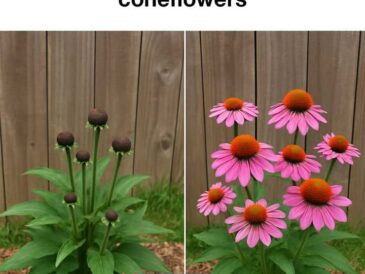Irises are a beloved addition to many gardens, known for their vibrant colors and intricate blooms. However, many gardeners find themselves puzzled when it comes to maintaining these beautiful plants. One of the most common mistakes is not dividing irises at the right time or in the right way, which can lead to overcrowding and reduced blooms.
Dividing irises is a crucial part of their care, ensuring that they continue to thrive and produce stunning flowers year after year. In this article, we will explore the life cycle of irises, why division is essential, and provide a step-by-step guide to doing it correctly. Whether you’re a seasoned gardener or a novice, understanding how to properly divide your irises will help you maintain a healthy and beautiful garden.
1. Understanding the Life Cycle of Irises
Irises are perennial plants that go through a cycle of growth, bloom, and dormancy. Typically, irises bloom in late spring to early summer, depending on the variety and climate. After blooming, the plants enter a period of growth where they store energy in their rhizomes for the next season.
The rhizomes, which are thick, fleshy roots, gradually spread and multiply, leading to clumps of irises. Over time, these clumps can become overcrowded, which can hinder their growth and flowering. Understanding this cycle is crucial for knowing when to intervene and divide the plants to ensure they remain healthy and productive.
2. Why Dividing Irises Is Essential
Dividing irises is essential for several reasons. Firstly, it prevents overcrowding, which can lead to competition for nutrients and water, resulting in weaker plants and fewer blooms. Secondly, dividing irises rejuvenates the plants, encouraging new growth and more vigorous flowering.
Additionally, dividing irises helps control pests and diseases. Overcrowded plants are more susceptible to issues such as rhizome rot and iris borers. By regularly dividing and replanting irises, you can maintain a healthier garden and enjoy more robust plants.
3. Identifying the Right Time to Divide
The best time to divide irises is during their dormant period, which is typically in late summer to early fall, about six to eight weeks after blooming. This timing allows the plants to recover and establish themselves before the onset of winter.
Look for signs that your irises need dividing, such as reduced blooms, smaller flowers, or rhizomes pushing out of the soil. If you notice these signs, it’s time to plan for division to ensure your irises remain healthy and vibrant.
4. Tools You Need for Dividing Irises
To divide irises, you’ll need a few essential tools: a sharp spade or garden fork, a clean knife or pruners, and a bucket of water. The spade or fork is used to carefully lift the clump of irises from the ground, while the knife or pruners are used to separate the rhizomes.
It’s important to ensure that your tools are clean and sharp to prevent damage to the plants and reduce the risk of disease. Additionally, having a bucket of water on hand can help keep the rhizomes moist while you work, preventing them from drying out.
5. Step-by-Step Guide to Dividing Irises
1. Begin by cutting back the iris foliage to about 6 inches to make handling easier.
2. Use a spade or garden fork to carefully dig around the clump, lifting it out of the ground.
3. Gently shake off excess soil and examine the rhizomes for healthy, firm sections.
4. Use a clean knife or pruners to cut the rhizomes into sections, ensuring each has at least one fan of leaves and healthy roots.
5. Discard any old, diseased, or damaged rhizomes.
6. Replant the divided rhizomes in a sunny location with well-draining soil, spacing them about 12 to 18 inches apart.
7. Water the newly planted rhizomes thoroughly to help them establish.
6. Common Mistakes to Avoid
One common mistake is dividing irises too early or too late in the season, which can stress the plants and affect their growth. Another mistake is planting the rhizomes too deeply; they should be just below the soil surface to prevent rot.
Additionally, failing to clean your tools between cuts can spread disease. Always ensure your tools are sanitized, and avoid dividing irises when the weather is extremely hot or wet, as this can hinder their recovery.
7. How to Care for Divided Irises
After dividing and replanting, it’s important to water the irises regularly, especially during dry spells, to help them establish. Mulching around the plants can help retain moisture and suppress weeds.
Fertilize the irises in early spring with a balanced fertilizer to promote healthy growth and flowering. Keep an eye out for pests and diseases, and address any issues promptly to ensure your irises remain healthy.
8. Popular Myths and Misconceptions
One common myth is that irises need to be divided every year. In reality, they typically only need dividing every three to five years, depending on their growth rate and conditions.
Another misconception is that irises are difficult to divide and care for. With the right knowledge and tools, dividing irises is a straightforward process that can greatly benefit your garden.
9. Viral Hacks: What Works and What Doesn’t
Some viral gardening hacks suggest using household items like vinegar or baking soda to treat iris pests or diseases. While these can sometimes be effective, they are not a substitute for proper care and maintenance.
Other hacks, like using coffee grounds as fertilizer, can be beneficial in moderation but should not replace a balanced fertilization routine. Always research and test any hacks on a small scale before applying them widely in your garden.
10. Signs Your Irises Need Dividing
Signs that your irises need dividing include reduced flowering, smaller blooms, and rhizomes that are overcrowded or pushing out of the soil. You may also notice that the center of the clump is dying out, with new growth only occurring at the edges.
If you observe these signs, it’s a good indication that your irises would benefit from division to rejuvenate the plants and improve their overall health.
11. Long-Term Benefits of Proper Division
Properly dividing irises can lead to healthier plants with more abundant and vibrant blooms. It also helps prevent the spread of diseases and pests, ensuring your garden remains beautiful and thriving.
In the long term, regular division promotes a more organized and manageable garden, allowing you to enjoy the full beauty of your irises without the hassle of overcrowding or declining plant health.




